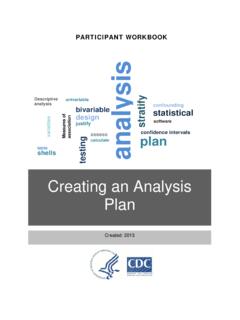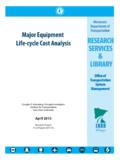Transcription of The author(s) shown below used Federal funding provided by ...
1 The author(s) shown below used Federal funding provided by the Department of Justice to prepare the following resource: Document Title: Decision Making in Sexual Assault Cases: Replication Research on Sexual Violence Case Attrition in the Author(s): Melissa S. Morabito, Linda M. Williams, April Pattavina Document Number: 252689 Date Received: February 2019 Award Number: 2012-IJ -CX-0052 This resource has not been published by the Department of Justice. This resource is being made publically available through the Office of Justice Programs National Criminal Justice Reference Service. Opinions or points of view expressed are those of the author(s) and do not necessarily reflect the official position or policies of the Department of Justice. This resource was prepared by the author(s) using Federal funds provided by the Department of Justice.
2 Opinions or points of view expressed are those of the author(s) and do not necessarily reflect the official position or policies of the Department of Making in Sexual Assault Cases This document is a research report submitted to the Department of Justice. This report has not been published by the Department. Opinions or points of view expressed are those of the author(s) and do not necessarily reflect the official position or policies of the Department of Justice Decision Making in Sexual Assault Cases: Replication Research on Sexual Violence Case Attrition in the Melissa S. Morabito University of Massachusetts Lowell School of Criminology & Justice Studies 113 Wilder Street Lowell, MA 01854 (p) 978-934-4256 Linda M. Williams Wellesley Centers for Women Wellesley College 106 Central Street Wellesley, MA 02481 (p) 781-283-2498 April Pattavina University of Massachusetts Lowell School of Criminology & Justice Studies 113 Wilder Street Lowell, MA 01854 (p) 978-934-4145 This project was supported by Award No.
3 2012-IJ-CX-0052 awarded by the National Institute of Justice, Office of Justice Programs, Department of Justice to the University of Massachusetts Lowell. The opinions, findings, and conclusions or recommendations expressed in this publication are those of the authors and do not necessarily reflect those of the Department of Justice. This resource was prepared by the author(s) using Federal funds provided by the Department of Justice. Opinions or points of view expressed are those of the author(s) and do not necessarily reflect the official position or policies of the Department of Making in Sexual Assault Cases This document is a research report submitted to the Department of Justice.
4 This report has not been published by the Department. Opinions or points of view expressed are those of the author(s) and do not necessarily reflect the official position or policies of the Department of Justice Abstract Decision-Making in Sexual Assault Cases: Multi-site Replication Research on Sexual Violence Case Attrition in the We report findings from a multi-site study of sexual violence case attrition in the -- a replication and extension of work conducted by researchers in Los Angeles. The attrition of sexual assault cases from the criminal justice system has been a concern to victims, practitioners and researchers for the last forty years. Some of the barriers come from police discouraging victims from filing a report while other problems result from prosecutors reluctant to prosecute cases. A growing body of research suggests that there is still much that can be done to support victims and to assure that the role of extra-legal factors in case attrition is minimized.
5 Spohn and Tellis (2012a) study made an important contribution to our understanding of the factors that explain sexual violence (SV) case attrition at the policing and prosecutorial stages, however their findings were specific to agencies in LA County. Thus there was a need to examine case processing in other jurisdictions to understand more about factors predictive of attrition. Our research is a multi-site replication designed to consider individual, locale, and community characteristics; victim advocacy; and police and prosecutorial responses. This research relied on a mixed methods approach using quantitative and qualitative data to uncover and interpret patterns in the attrition of sexual assault cases. In six jurisdictions we tracked reports of rape and attempted rape cases and documented the flow of reports through each stage; analyzing detailed case records to understand the dynamics including victim, offender and case characteristics associated with attrition; and conducting interviews and focus groups with key personnel: police, prosecutors and victim service providers.
6 Between 2008-2010, 3269 complaints of sexual assault were reported to one of the six jurisdictions in our sample1. For this replication study we report results on case attrition for the 2887 female victims who reported sexual assault. 1404 ( ) of cases were cleared by the police; 544 ( ) were cleared by arrest; 860 ( ) were exceptionally cleared; 1215 ( ) were listed as open/inactive; and 56 ( ) were listed as investigation continuing. 212 cases ( ) were unfounded by the police. Of the 544 adults arrested, charges were filed in 363 (72%); declined in 115 ( ). In cases with charges filed, 189 ( ) ended in a guilty verdict; 152 (81%) of guilty verdicts were the product of a plea bargain; 7 ( ) involved a guilty finding by a judge and 25 ( ) involved a guilty finding by a jury. In 11 cases, a jury acquitted the defendant following a trial. Only 45 ( ) of cases reported to the police during across all 6 sites were tried in court.
7 Multivariate analyses predicting arrest show that legal or evidentiary factors are significant predictors of arrest and that the effects of case characteristics are independent of jurisdiction type. A cooperative victim was the strongest predictor of arrest across all jurisdictions. Medium and large jurisdiction results show that questions related to victim credibility reduced the likelihood of arrest although the type of credibility indicators varied. Race was a significant predictor only for small sites with higher odds of arrest for incidents involving black victims. Notably we found that extra-legal factors significantly predicted arrest and were often those that challenge the credibility of the victim, in contrast to Spohn and Tellis who found that arrest was unrelated to whether victims had mental health issues or engaged in risk taking behavior. Spohn and Tellis did not find any effect of race on the likelihood of arrest.
8 Indicators of victim resistance were predictive of arrest of all relationship types in the replication study in contrast to Spohn and Tellis. Victim cooperation was found to be significant for all relationship types in both studies in predicting arrest. 1 Cases were collected from 2006-2012 in small sites to insure a large enough sample of sexual assault complaints for statistical analysis and comparison to medium and large sites. This number includes cases reported by males; however, our detailed analyses of predictors of attrition relies on the sample of 2887 reports by females because our analyses were a replication of Spohn and Tellis. This resource was prepared by the author(s) using Federal funds provided by the Department of Justice.
9 Opinions or points of view expressed are those of the author(s) and do not necessarily reflect the official position or policies of the Department of Making in Sexual Assault Cases Table of Contents. This document is a research report submitted to the Department of Justice. This report has not been published by the Department. Opinions or points of view expressed are those of the author(s) and do not necessarily reflect the official position or policies of the Department of Justice DECISION MAKING IN SEXUAL ASSAULT CASES: REPLICATION RESEARCH ON SEXUAL VIOLENCE CASE ATTRITION IN THE TABLE OF CONTENTS Executive Section I Literature Police Decision-Making in Cases of Sexual Assault Prosecutorial Decision Making in Cases of Sexual Assault Literature on Clearance of Cases Literature on Victim Cooperation The Relationship Between Police and Prosecutor Case Flow and Management Size of Jurisdiction and Other Organizational Features National Incident Based Reporting System (NIBRS) and Clearance by Exceptional Means Research Design and Study Approach Data Collection Methods Data Analysis Section II.
10 Overview of Case Attrition, Summary of Outcomes Detailed Comparison of Our Study results to the Spohn and Tellis Findings This Project s Overall Case Attrition Finding and Comparison to Spohn and Tellis Summary and Conclusions Section III: Case Outcomes for Rape and Attempted Rape, Case Outcomes Victim, Suspect, and Case Characteristics Summary Section IV: Unfounding Sexual The Use of Unfounding Case Characteristics Section V: The Overuse of the Exceptional The Overestimation of the Clearance Rate Case Characteristics Evaluating Exceptional Clearance Qualitative Analysis Section VI: The Correlates of Case Modeling Case Outcomes The Decision to Arrest the Suspect Analysis of Arrest Outcomes Partitioned by Relationship Type Exceptional Clearance The Decision to Prosecute the Suspect Case Characteristics and Convictions for Cases with Charges Lodged This resource was prepared by the author(s) using Federal funds provided by the Department of Justice.












